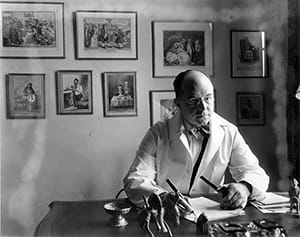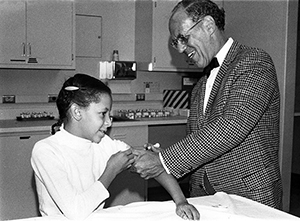Convalescent Home pioneered comprehensive care
For nearly 100 years, the Convalescent Home for Children provided long-term care for children with chronic illness and disabilities. Its association with and gradual incorporation into Children’s Hospital Medical Center remains an outstanding early example of comprehensive, coordinated, multidisciplinary service.
It began in 1833 as an orphan asylum, caring for children left parentless by twin local disasters: the Ohio River flood of 1831, followed by a cholera epidemic. Its focus, however, gradually turned to the care of disabled and chronically ill children, a transition championed by Pediatric Chair A. Graeme Mitchell, MD, who believed orphans were better off in foster care. In 1930, the Convalescent Home of the Cincinnati Orphan Asylum relocated to a new facility in Mt. Auburn, not far from the original site of Children’s Hospital, which had moved to its current address in Avondale one year earlier.
Although it was an independent non-profit institution, initially funded by charitable donations, the Convalescent Home enjoyed a collaborative relationship with Cincinnati Children’s and the Department of Pediatrics from its very beginning. Pediatric specialists and community pediatricians consulted there, and Convalescent patients were transported to and from Children’s Hospital for X-rays and surgery. Mitchell appointed his associate, Waldo Nelson, MD, as The Convalescent Home’s first medical director. Junior pediatric residents served two-month-long rotations at the “Con.”
The facility was built to house 100 children and usually operated at 70-80 percent capacity. Patients were segregated by age and sex in 12 wards on the first floor, along with offices and the dining room. Rehabilitative services were on the second floor; the ground floor housed the classrooms, playroom, library and kitchen. The wards were situated around an outdoor terrace, where children were often brought for fresh air and recreation.
The residents of the home stayed anywhere from several months to many years. They suffered from a variety of ailments, some familiar, and some which have fortunately become quite rare: severe scoliosis as a result of polio or tuberculosis; cerebral palsy; spina bifida; seizure disorders; rheumatic fever; rheumatoid arthritis; cystic fibrosis; asthma, and lead intoxication. In those days, children recuperating from rheumatic fever and major surgery were typically kept on strict bedrest for many months, followed by physical rehabilitation for atrophied muscles. As counterproductive as that strategy sounds today, in an era before antibiotics, modern surgical techniques, and extensive home-health services, the ONLY effective therapeutic modalities were often rest, good nutrition and clean air.
Focus on whole child
The Convalescent Home’s program was truly innovative for its time, providing “holistic” care to chronically ill children that addressed not only their medical conditions, but educational and psychological needs as well. The Board of Education supplied teachers for grades 1 through 12. In the ’50s, preschool/kindergarten programs were added. Those children who could leave the facility were taken on field trips to places like the zoo and the art museum. There were holiday celebrations and pageants, which the older children would help plan, and frequent visits from community entertainers. Parental visitation was encouraged, though limited to two hours per day. Some children were allowed to return home once a month, though rarely for overnight visits. Once a child was well enough to be discharged, Social Services assisted in their transition back home.
A unique glimpse into life at the Con has been provided by a young woman named Barbara, who lived there for three years as a teenager in the mid-1950s, while being treated for polio-induced scoliosis. In 2005, she shared her recollections in an unpublished memoir. The overall atmosphere at the Con, as she relates it, sounds much like a boarding school. She says little about her treatments but fondly remembers classes and recreation, friendships and rivalries. One of the nurses taught her to knit. She and her roommates enjoyed regular “teen nights,” where they listened to records, played cards and checkers, and snacked on Cokes and popcorn. They became quite attached to the evening shift nurse, “Mother Schwarberg,” even at one point staging a group protest to get her reassigned to their ward.
Assembling the team
In 1955, the Con became an accredited hospital and from that time forward was usually referred to as the Convalescent Hospital. Quite a few Children’s Hospital specialists were instrumental in the ongoing improvement and expansion of services that led to this accreditation.
Richard Wolf, MD, served as the Con’s medical director during World War II and then later went into the field of child psychiatry, sharing his expertise with the children living under these extraordinary circumstances.
Louise Rauh, MD, managed the rheumatic fever and cardiac patients at a time when treatment was mostly palliative.
Aaron Perlman, MD, began serving as attending physician at the Con in 1951 and became director of Pediatric Orthopaedics in 1965. The Cerebral Palsy Clinic that he founded in 1950 evolved into United Cerebral Palsy.
Joseph Levinson, MD, started consulting on pediatric rheumatology cases at the Con in 1956 and would go on to found the Special Treatment Center for JRA there in the early 1960s.
Joseph Ghory, MD, Cincinnati’s first pediatric allergist, became medical director of the Con in 1961. For years he and his colleagues ran a novel intensive inpatient management program for chronic asthmatics, which included medication protocols, breathing exercises and physical conditioning, and – unique for its time – an air-conditioned environment. Aminophylline suppositories, epinephrine injections, Isuprel inhalations and oral steroids were the only treatments available back then.
By the 1960s, innovations in medical and surgical care had resulted in a change in the profile of patients requiring convalescent services. Rheumatic fever, tuberculosis, and polio cases were declining. However, improved survival of premature infants had created a host of new conditions: broncho-pulmonary dysplasia, failure to thrive, severe perinatal brain damage. The Con also started evaluating and actually treating children with developmental and behavior disorders, who in the past may have been merely institutionalized and forgotten.
At this same time, serious discussion was taking place about relocating the Con to the Children’s Hospital campus, as well as formalizing the relationship between these two institutions and other related and emerging community health services: United Cerebral Palsy; the Special Treatment Center for Juvenile Arthritis, the Children’s Dental Care Foundation, and The Adolescent Clinic. In December 1973, the Pavilion (now Location E), opened, uniting all of these services, including the Convalescent Hospital, under one roof. This was the birth of Cincinnati Children’s Hospital Medical Center.
The Convalescent Hospital for Children has continued to support the care of chronically ill children, many of whom now suffer from behavioral disorders and mental illness, and are managed at the College Hill Campus. How that came about – well, that’s another story!
-- M. Elaine Billmire, MD





